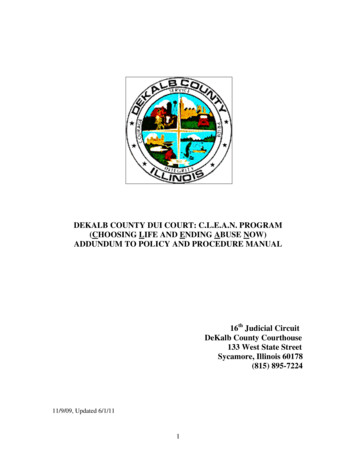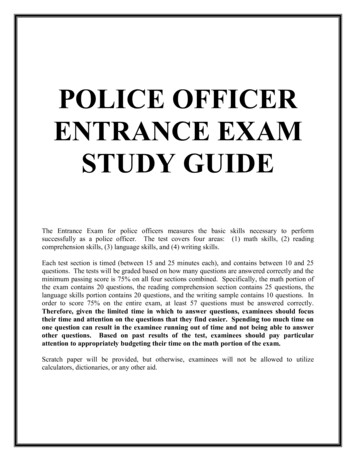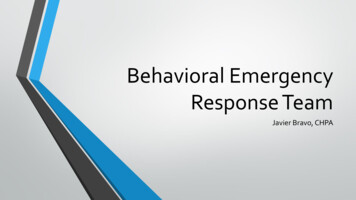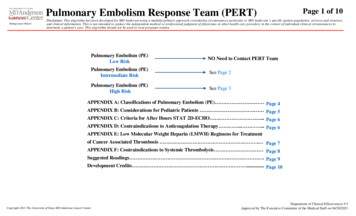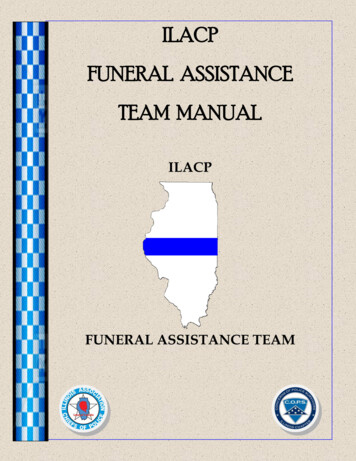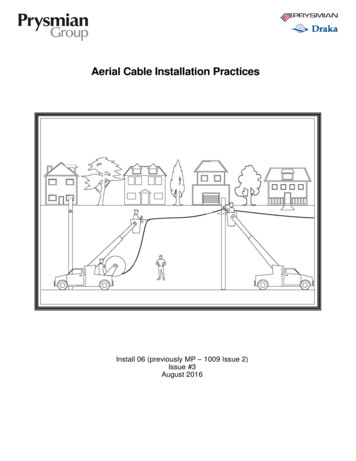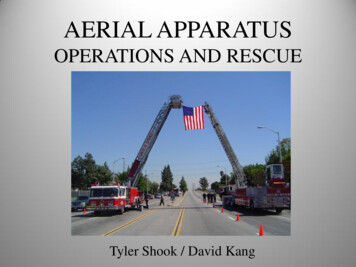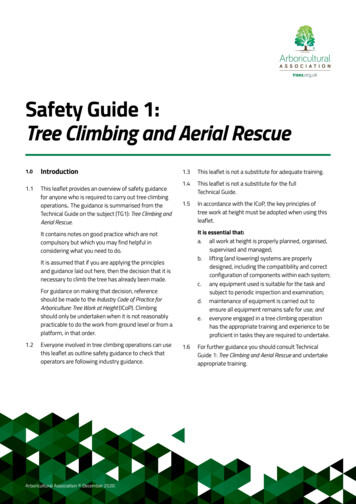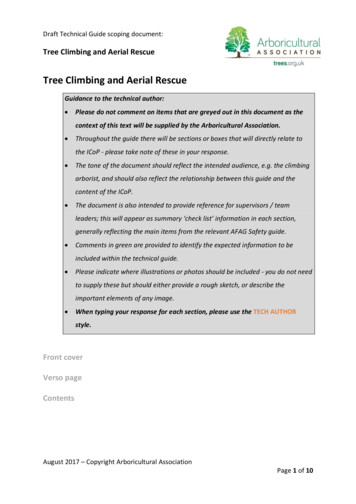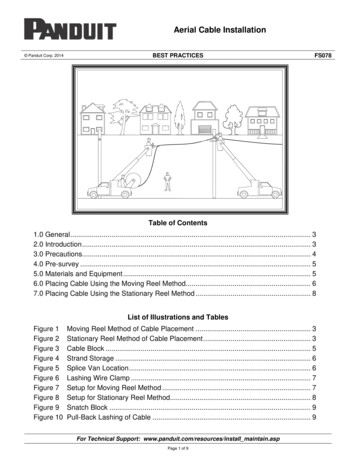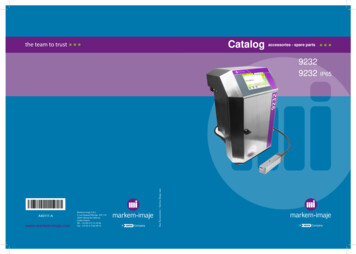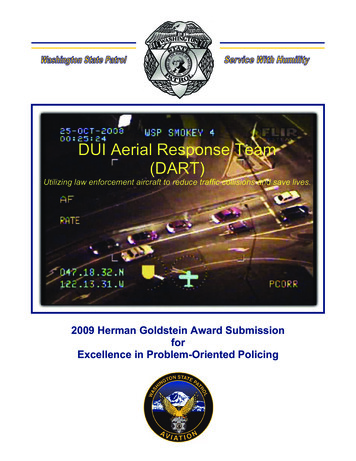
Transcription
DUI Aerial Response Team(DART)Utilizing law enforcement aircraft to reduce traffic collisions and save lives.2009 Herman Goldstein Award SubmissionforExcellence in Problem-Oriented Policing
CHRISTINE O. GREGOIREGovernorJOHN R. BATISTEChiefSTATE OF WASHINGTONWASHINGTON STATE PATROLGeneral Administration Building PO Box 42600 Olympia, WA 98504-2600 (360) 596-4000 www.wsp.wa.govMay 28, 2009Rob T. Guerette, Ph.D.School of Criminal JusticeFlorida International UniversityUniversity Park PCA 366B11200 S.W. 8th StreetMiami, FL 33199Dear Dr. Guerette:It is with great pleasure that I submit the Washington State Patrol’s “DUI Aerial Response Team(DART)” program for consideration for the 2009 Herman Goldstein Award for Excellence in ProblemOriented Policing.As outlined in the submission instructions, our project is submitted in electronic (PDF) format as ane-mail attachment.By this letter, I attest to the program’s methodology and verify that the program results are accurate anddirectly attributable to the DART program.In addition to nominating this program for award consideration, I ask that it also be considered forpresentation at the 2009 POP Conference.If you have any questions about this project, please contact Lieutenant Tristan K. Atkins, AviationSection, at (360) 753-6173.Sincerely,CHIEF JOHN R. BATISTEJRB:tkacc: Lieutenant Tristan K. Atkins, Aviation SectionCaptain Mark Couey, Special Operations DivisionAssistant Chief Brian A. Ursino, Investigative Services Bureau
Table of ContentsPageSummary. 1Description of ProgramScanning . 3Analysis . 5Response . 9Assessment . 14Agency and Officer Information . 18AppendicesAppendix 1: Figures. 19Appendix 2: Tables . 23Appendix 3: Photographs . 24Appendix 4: Media (Public Education) . 26Appendix 5: DART Procedures . 31Front cover: The picture on the cover was taken by the WashingtonState Patrol’s Forward-Looking Infrared (FLIR) stabilized video camera onOctober 25, 2008, from 2,000 feet above the ground. DART aircrewobserved the red passenger car (behind the white car in the left lane)driving erratically on Interstate 5 near Tacoma. They followed thesuspect’s vehicle for over 12 miles into the city of Auburn whilecoordinating the stop with ground troopers (trooper’s vehicle shown inbottom left of video image). Minutes after this video scene, a short vehiclepursuit ensued, followed by a 45-minute foot pursuit. The DART aircrewsuccessfully tracked the suspect, resulting in his apprehension by troopersand Auburn Police Department K-9 units. The suspect was arrested forDUI, felony eluding, possession of cocaine, and reckless endangerment.
SummaryProgram TitleScanningDUI Aerial Response Team (DART)The leading cause of traffic deaths in Washington State isdriver impairment due to alcohol or drugs. In 2007, Washington State Patrol (WSP)Communications Centers in the Puget Sound metropolitan areas of Seattle, Tacoma, andEverett received 28,746 calls from citizens reporting erratically driven (possible DUI) vehicles.Initial estimates indicated that very few of these reported vehicles were contacted by lawenforcement.AnalysisA statistical baseline revealed that in the Puget Soundmetropolitan area, less than 1 in 20—or approximately 4% of vehicles reported by citizens aserratically driven—were stopped by troopers. Of those 4% contacted by troopers,approximately 38% were arrested for Driving Under the Influence (DUI).The WSP recognized that specially equipped aircraft were essential to the success of any aerialDUI program. Two existing WSP Cessna airplanes had been equipped with Forward-LookingInfrared (FLIR) cameras, and microwave downlink using post-9/11 federal homeland securityfunding. While these aircraft were not originally envisioned for DUI enforcement, their ability toenhance the agency’s efforts to reduce traffic fatalities and collisions was readily apparent.ResponseIn 2007, the WSP Aviation Section developed an innovativeaerial traffic safety program called DUI Aerial Response Team (DART). DART is the firstprogram in the nation to use FLIR-equipped airplanes to locate, track, and coordinate theapprehension of impaired, reckless, and aggressive drivers. DART effectively combinesproactive aerial DUI patrols with a rapid air response to citizen reports of erratically drivenvehicles (Figure 1, page 19).Page 1
SummaryThe goals of DART are: Decrease traffic fatalities and collisions. Enhance public education of the dangers of drunk driving. Increase citizen-reported DUI’s contacted by a trooper from 4% to 25%. Of those contacted, increase DUI arrests from 38% to 50%.AssessmentDuring a ten-month period (July 2008 – April 2009), fatalitycollisions decreased 25% and injury collisions decreased 21%, compared to the same period in2007/2008. The following DART outcomes contributed to these decreases in collisions: Citizen-reported DUI’s contacted by troopers increased from 4% to 28%. DUI arrests increased from 38% to 44%. Over 60 media stories were attributed to the DART program, resulting in a positive deterrenteffect.The success of DART has led to increased cooperation between regional law enforcementagencies, including joint DUI emphases utilizing WSP aircraft. Law enforcement officers acrossthe region have embraced DART as a means to reduce collisions and save lives.Page 2
Description of Program: ScanningProblem DefinitionAccording to the Washington Traffic Safety Commission (WTSC), the number one factorcontributing to traffic deaths in Washington State is driver impairment (Figure 2, page 19). In2007, traffic collisions killed 571 people in Washington State. Drunk drivers accounted for 41%of total deaths in Washington State versus 32% nationwide.In 2007, WSP Communications Centers received 37,588 calls from citizens reporting erraticallydriven (possible DUI’s) vehicles statewide. Of those calls, 28,746 (or 76%) originated from thePuget Sound region. Less than 8% of erratic vehicles reported to the WSP statewide werestopped by troopers. In the Puget Sound metropolitan areas of Seattle, Tacoma, and Everett,only 4% were contacted by troopers. Of those 4% contacted, nearly 38% were arrested for DUI.How Did We Become Aware of the Problem?WTSC studies indicate over 50% of all traffic fatalities (Figure 3, page 20) and nearly 70% ofimpaired-driver-involved fatalities occur at night (Figure 4, page 20). While the WSP AviationSection (Photo 1, page 24) was aware of this problem, agency aircraft were not equipped fornighttime tactical law enforcement missions. Historically, WSP pilots conducted aerial trafficenforcement and other public safety missions during daylight hours.Starting in 2005, the WSP Aviation Section significantly enhanced its aerial public safetycapabilities through federally funded day/night FLIR camera and microwave downlink systems.These technology upgrades allowed WSP Aviation Section personnel to better examine trafficsafety problems and expand their missions into nighttime hours in support of agency missionsand goals. These upgrades also added a new dimension to the Aviation Section’s ability toeffectively provide aerial law enforcement and public safety services.Page 3
ScanningWith over 50 years of aerial traffic enforcement history during the day, WSP pilots wereconvinced that with newly upgraded airplanes, they could proactively locate, track, andcoordinate the apprehension of drunk drivers—day and night. Equally important, they wereconfident they could provide a rapid air response to citizen reports of erratically driven vehicles,significantly increasing the citizen-reported DUI apprehension rate. These initiatives, coupledwith increased media coverage/public education, would save lives by decreasing traffic fatalitiesand collisions.Page 4
AnalysisMethods and Data Used to Analyze the ProblemFirst-hand observation and preliminary research conducted by the WSP Aviation Sectionindicated that troopers contact a small percentage (4%) of citizen-reported erratically drivenvehicles. To better understand the problem, the Aviation Section conducted a “test of concept”aerial DUI emphasis with a media kick-off event over Memorial Day Weekend 2007.The emphasis was considered a success, because it validated that a specially equippedairplane could effectively locate, track, and coordinate the apprehension of drunk drivers. Thesuccess was reinforced when aerial video from the emphasis aired on four of Seattle’s majortelevision news stations. More importantly, analysis of the first aerial DUI emphasis led to thedevelopment of a statistical baseline and a commitment by the Aviation Section to move forwardwith a permanent aerial DUI program.Statistical Baseline EstablishedAdditional research by the WSP Communications Division in July 2007, using Bi-Web data fromComputer-Aided Dispatch (CAD) software, established a statistical baseline that verified ourinitial estimate indicating that only a small percentage of citizen-reported erratically drivenvehicles were contacted by law enforcement (Table 1, page 23).The statistical baseline was derived from citizen reports of erratically driven vehicles received ateight WSP Communications Centers over a six-month period (January-June 2007). Thisbaseline study provided the following data by each WSP district:1. Number of citizenreported erraticallydriven vehicles2. Number of citizenreported vehiclescontacted by troopersPage 53. Number of driverssubsequently arrestedfor DUI
AnalysisThe baseline revealed that statewide, less than 8% of citizen-reported vehicles were stopped bytroopers. In the Puget Sound metropolitan area, the percent contacted by troopers was only4%. However, of the 4% stopped, nearly 38% were arrested for DUI. It became evident thatcitizens were “getting it right” when reporting possible drunk drivers. The problem was a troopernot being in the vicinity to respond and take the “hand-off” from the citizen caller. WSP Aviationpersonnel wanted to close this gap and felt the solution lie in its specially equipped airplanes.Stakeholders Identified and Input SolicitedEarly in the process, funding requirements drove the identification and development ofstakeholders. Initial funding was obtained as a result of an innovative partnership with NavyRegion Northwest (NRNW), while subsequent federal funding was obtained from the UrbanArea Security Initiative (UASI).The WSP recognized early that specially equipped aircraft were essential to the success of anyaerial DUI program (Photos 2 and 3, pages 24/25). A stabilized imaging system with ForwardLooking Infrared (FLIR) camera and zoom capabilities was a must. Since approximately 70% ofimpaired driver-involved fatalities in Washington State occurred at night, it was critical thatthese aircraft be configured for safe night tactical operations. This included the installation of aTerrain Awareness and Warning System (TAWS) and a radar altimeter in each DART airplane.In 2005, using federal homeland security funding, two WSP airplanes were equipped with FLIR,microwave downlink, and digital video recorders. Additional federal funding in 2006-2008 wasused to purchase TAWS, radar altimeters, Iridium satellite phones, and Global PositioningSystem (GPS) moving maps. While these specially equipped airplanes were not originallyenvisioned to conduct DUI enforcement, it quickly became apparent to WSP aircrews that theywould be effective tools to help the agency address a core mission—DUI enforcement.Page 6
AnalysisStakeholder input, involvement, and commitment were crucial to the successful implementationof the DART program. In fact, the concept of stakeholder involvement was integrated into theprogram’s eventual name: DUI Aerial Response Team. The team of primary stakeholdersconsists of: WSP Aviation Section WSP Field Operations Bureau (FOB) district troopers WSP Communications Division Motorists armed with cellular phonesThe four primary stakeholders had an integral role in day-to-day development of the DARTprogram and provided the following resources: WSP Aviation Section:Aircraft, aircrews, and aircraft maintenance services. WSP Communications:Communications Officers, 911 call center, and CAD. WSP FOB/Districts:Line troopers trained to work with the aircraft to stop violators. Motorists/Citizens:“Eyes and ears” with cellular phones to report possible DUI’s.The WSP Aviation Section solicited input from the primary stakeholders often and early in theprocess. Primary stakeholder input, combined with lessons learned from “test of concept” andoperational testing aerial DUI emphases led to the following assumptions: DART is most effective when the reporting citizen is kept on the line until the aircraft isoverhead. Effectiveness is improved when aircrew communicate directly with the reporting citizen. Downlink of aerial video into WSP Communications Centers improved situational awareness. DUI emphases with an aircraft require prior coordination between aircrews, district, andcommunication (dispatch and 911) personnel. Written procedures reinforced with training were required prior to operational phase.Page 7
AnalysisWhile secondary stakeholders did not have a role in day-to-day development of the DARTprogram, their input and resources were critical to attaining milestones. Secondarystakeholders provided the following resources: Washington Traffic Safety CommissionTraffic safety funding and program support. WSP Information Technology Division (ITD)Remedy tracking software required to assess results. Mothers Against Drunk Driving (MADD)Network of anti-drunk driving activists and infrastructure for public education efforts. WSP Government and Media Relations (GMR)Media expertise and coordination efforts. Snohomish County Department of Emergency Management (DEM)Facility with FLIR receiver to host media events and aerial DUI emphases. Washington State Emergency Management Division (EMD)Provided technical expertise to view “real-time” video from DART missions on internet.Page 8
ResponseGoals of the DUI Aerial Response Team (DART)In an effort to reduce traffic fatalities and collisions, WSP Aviation developed an innovativeaerial traffic safety program in 2007/08. The initiative, called the DUI Aerial Response Team(DART), is the first program in the nation to use FLIR-equipped airplanes to locate, track, andcoordinate the apprehension of impaired, reckless, and aggressive drivers.The primary goals of DART are: Decrease traffic fatalities and collisions with specially equipped airplanes. Enhance public education of the dangers of drunk driving and discourage individuals whohave been drinking from getting behind the wheel.The secondary goals of DART are: Increase citizen-reported DUI’s contacted by troopers from 4% to 25%. Of those contacted, increase DUI arrests from 38% to 50%.Response Used to Resolve the ProblemDART was envisioned as a team effort comprised of citizens armed with cellular phones, WSPaircrews, ground troopers, and WSP Communications Officers to effectively combine proactiveaerial DUI patrols with a rapid air response to citizen reports of erratically driven vehicles (Figure 1,page 19).Based on analysis of aerial DUI emphases conducted in 2007, we learned that DART providesnumerous advantages over the traditional method of responding to citizen reports of possibledrunk drivers, including: Rapid response: Flying above traffic congestion at over 160 mph allows WSP aircrews toarrive over a citizen-reported erratically driven vehicle, typically in less than five minutes.Page 9
Response Aerial view: With an “Eye in the Sky” view (Photo 4, page 25), DART aircrews easily directtroopers to suspected drunk drivers while developing probable cause for a stop. Improved officer safety: After the stop, DART aircrews remain overhead—with the videorunning and ready to call for help—until the suspect is in custody.While the most expensive technology required for a successful aerial DUI program—FLIR andmicrowave downlink systems—was purchased with federal homeland security grant monies in2005, additional equipment was needed for effective night operations. Federal funding from theUrban Area Security Initiative (UASI) in 2007 and 2008 facilitated full implementation of theDART program. With UASI funding, two WSP Cessna 206 airplanes (known as Smokey 3 andSmokey 4) were configured for night tactical operations with a Terrain Awareness and WarningSystem (TAWS), radar altimeter, and GPS moving map systems.The DART concept was tested over Memorial Day Weekend in May 2007 with a DUI emphasisand media kick-off event at the Snohomish County Emergency Operations Center (EOC)located in Everett. The emphasis resulted in 11 erratically driven vehicle contacts, including 1reckless driving arrest, 1 open container, and 2 DUI arrests. Two Seattle television newsstations covered the event live. The emphasis resulted in 15 media stories, including front pagecoverage in the Everett Herald [Media (Public Education), page 26].Operational testing began Labor Day Weekend, August 2007, with a highly publicized DUIemphasis in the Seattle metropolitan area. DART aircrews responded to three citizen-reportedDUI’s and coordinated the arrests of one reckless driver, two negligent drivers, and one felonyeluding suspect. The Everett Herald covered an aggressive driving emphasis that led up to theevening DUI emphasis, and four Seattle television news stations provided live reports of thisspecial emphasis.Page 10
ResponseThe Labor Day Weekend emphasis identified the need for aircrews to communicate directly withthe reporting citizens following potentially drunk drivers. A previously approved UASI federalgrant was modified to allow the purchase of two satellite phone systems, which were installedby WSP Aviation Section aircraft maintenance technicians in June 2008.Following the Labor Day Weekend emphasis, tactics and techniques were further refined andwritten into published DART procedures (DART Procedures, page 31). With a writtenprocedure in place, WSP Aviation Section personnel took on the task of trainingCommunications Officers and commissioned supervisory personnel on the roles andresponsibilities of WSP personnel during DART missions. The training included a PowerPointpresentation with embedded media videos from previous aerial DUI emphases.In April 2008, a trooper was reassigned from the Field Operations Bureau to the AviationSection to serve as a full-time Tactical Flight Officer (TFO). The TFO is an essential member ofthe DART aircrew and operates the stabilized FLIR camera/video, microwave downlink system,digital recorder, GPS moving map system, Mobile Communications Network (MCN) computeruplink/downlink, voice over video overlay system, satellite phone systems, and law enforcementradios.With enhanced staffing, additional technology upgrades, and newly trained personnel, theDART progr
In 2007, the WSP Aviation Section developed an innovative aerial traffic safety program called DUI Aerial Response Team (DART). DART is the first program in the nation to use FLIR-equipped airplanes to locate, track, and coordinate the apprehension of impaired, reckless, and aggressive drivers. DART effectively combines
